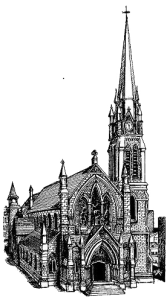The Parish of Saint John at Trinity Church has played an important spiritual role in the community of Saint John since 1783. The evolution and growth of Trinity as a community has continued to this day, meeting and overcoming challenges along the way.
The style of architecture of the present building is Victorian Gothic, and typifies the architecture introduced in New Brunswick by the Bishop of Fredericton, John Medley, an early advocate and pioneer of this style. Medley wanted Church buildings that proclaimed the glory, beauty and mercy of God. He would have approved of the words Abbot Suger inscribed on the doors of the first Church built entirely in the Gothic style in the 1140′s at St. Denis, near Paris.
The church was designed by W.T. Thomas of Montreal and the contract price for both church and school house was $55,985. The walls are built of limestone of rough ashlar, laid in regular courses, with freestone trimmings on a heavy base of granite. The pillars in the nave are formed of one piece of polished grey granite, with carved capitals surmounted by freestone arches. The interior woodwork is of black ash with black walnut moldings. A severely plain exterior is relieved at the West entrance by handsome granite steps and a richly molded archway terminating in a cross over the doors. It was under the leadership of The Rev. Canon F.H.J. Brigstocke that the present church was erected. The Cross on the Altar is a memorial to Archdeacon Brigstocke.
The church is 150 feet in length. The chancel is forty feet deep and thirty-three feet wide. The nave is 62 feet wide overall, and 110 feet long with an expansive height of 64 feet. The nave originally seated 800 people, but today accommodates about 650 people.
The bell tower and steeple rise to the majestic height of 210 feet and is topped by a weathervane in the form of a six foot long wood gilt fish. The fish was the early symbol for Christianity, and is still used today. The tower contains a clock and a ring of nine bells, a gift installed in 1882 by the City of Saint John. The clock was constructed to chime the quarters and strike the hours on the bells. By means of a carillon, tunes were played on the hours of three, six, nine, and twelve.

The noble work is bright, but, being nobly bright, the work should brighten our minds, allowing them to travel through the lights to the true Light, where Christ is the true Door.
The dull mind rises to the truth through material things, and is resurrected from its former submersion when the Light is seen.
In Memoriam the Loyalists 1783:
Faithful alike to God and the King.
If you are visiting, we invite you to take our Self-Guided Tour of Trinity.


